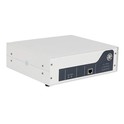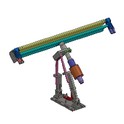In the realm of wood processing, the quest for more efficient, precise, and innovative techniques is unending. As a supplier of 2000W ultrasonic generators, I often encounter inquiries about the applicability of our product in wood processing. This blog aims to delve into the scientific aspects of using a 2000W ultrasonic generator for wood processing, exploring its potential, limitations, and practical considerations.
Understanding Ultrasonic Technology
Before discussing its application in wood processing, it's essential to understand what ultrasonic technology is. Ultrasonic waves are sound waves with frequencies higher than the upper audible limit of human hearing, typically above 20 kHz. An ultrasonic generator is a device that produces these high - frequency electrical signals, which are then converted into mechanical vibrations by a transducer.
The power of an ultrasonic generator, such as our 2000W model, determines the intensity of the ultrasonic waves it can generate. Higher power generally means more energy is available to perform work, but it also requires careful consideration of the application's requirements and the materials involved.
Potential Applications of a 2000W Ultrasonic Generator in Wood Processing
Wood Drying
One of the most promising applications of ultrasonic technology in wood processing is wood drying. Traditional wood drying methods, such as air drying and kiln drying, can be time - consuming and may cause cracking, warping, or other defects in the wood. Ultrasonic waves can accelerate the drying process by creating cavitation bubbles in the wood's moisture. These bubbles implode, generating micro - jets that help to expel moisture from the wood more quickly.
A 2000W ultrasonic generator can provide sufficient power to penetrate relatively thick wood pieces and create the necessary cavitation effect. However, the effectiveness of ultrasonic drying depends on factors such as the wood species, its initial moisture content, and the frequency of the ultrasonic waves.
Wood Bonding
Ultrasonic welding and bonding are also areas where a 2000W ultrasonic generator can be useful in wood processing. Ultrasonic energy can be used to soften adhesives or melt thermoplastic materials used in wood bonding. When applied to wood joints, the high - frequency vibrations can cause the molecules in the adhesive or the wood surface to move rapidly, creating frictional heat that promotes bonding.
The 2000W power level allows for the rapid heating and bonding of larger wood pieces or joints with higher bonding requirements. This can lead to stronger and more durable wood connections compared to traditional bonding methods.
Wood Cutting and Machining
In theory, ultrasonic waves can be used to assist in wood cutting and machining. The high - frequency vibrations can reduce the friction between the cutting tool and the wood, resulting in smoother cuts and less tool wear. A 2000W ultrasonic generator can provide enough power to enhance the cutting performance, especially when used with specialized ultrasonic - assisted cutting tools.
Limitations and Challenges
Wood Properties
Wood is a heterogeneous and anisotropic material, which means its properties vary depending on the direction of the grain and the wood species. Different woods have different densities, moisture contents, and fiber structures, which can affect the propagation of ultrasonic waves. For example, dense hardwoods may absorb more ultrasonic energy than softwoods, requiring adjustments in the generator's power and frequency settings.
Energy Consumption and Heat Generation
A 2000W ultrasonic generator consumes a significant amount of electrical energy. In addition, the conversion of electrical energy into ultrasonic vibrations is not 100% efficient, and some of the energy is dissipated as heat. Excessive heat generation can cause damage to the wood, such as charring or thermal degradation. Therefore, proper cooling and heat management systems need to be in place when using a high - power ultrasonic generator.
Cost and Equipment Complexity
The cost of a 2000W ultrasonic generator and the associated equipment, such as transducers and controllers, can be relatively high. Moreover, setting up an ultrasonic wood processing system requires technical expertise to ensure proper operation and maintenance. This can be a barrier for small - scale wood processing enterprises.
Practical Considerations
Frequency Selection
The frequency of the ultrasonic waves is a crucial factor in wood processing. Different frequencies have different penetration depths and cavitation effects in wood. For example, lower frequencies (e.g., 20 - 40 kHz) are better suited for deeper penetration, which is useful for drying thick wood pieces. Higher frequencies (e.g., 40 - 100 kHz) are more effective for surface - related processes such as bonding and cutting. A 2000W ultrasonic generator is usually adjustable in frequency, allowing for optimization based on the specific wood processing task.
Safety Precautions
When using a 2000W ultrasonic generator, safety is of utmost importance. Ultrasonic waves can be harmful to human health if proper precautions are not taken. Operators should wear appropriate personal protective equipment, such as ear protection, to prevent hearing damage from the high - frequency noise. In addition, the generator should be installed in a well - ventilated area to prevent overheating and to ensure the safe dissipation of any fumes or gases generated during the wood processing.
Comparison with Other Power - Level Ultrasonic Generators
While a 2000W ultrasonic generator has its advantages in wood processing, it's also important to consider other power - level options available in the market. For example, a 500W Ultrasonic Generator may be more suitable for small - scale or delicate wood processing tasks, where less power is required to avoid damaging the wood.


On the other hand, a 3000W Ultrasonic Generator or a 6000W Ultrasonic Generator can provide even more power for large - scale or high - intensity wood processing operations, such as drying very thick wood beams or bonding large - area wood panels.
Conclusion
In conclusion, a 2000W ultrasonic generator has significant potential for use in wood processing, particularly in applications such as wood drying, bonding, and cutting. However, its effectiveness depends on a variety of factors, including the wood properties, the specific processing task, and the proper adjustment of the generator's settings.
While there are limitations and challenges associated with using a 2000W ultrasonic generator, such as energy consumption, heat generation, and cost, the benefits it offers in terms of improved efficiency, quality, and reduced processing time make it a viable option for many wood processing enterprises.
If you are interested in exploring the use of a 2000W ultrasonic generator for your wood processing needs, I encourage you to contact us for more information. Our team of experts can provide detailed technical support and help you determine the best solution for your specific requirements.
References
- [1] M. A. Alagusundaram, et al., "Ultrasonic drying of agricultural products: A review," Journal of Food Engineering, vol. 107, pp. 31 - 42, 2011.
- [2] D. A. D. Grewell, et al., "Ultrasonic processing of polymers and composites," Composites Part A: Applied Science and Manufacturing, vol. 39, pp. 1035 - 1042, 2008.
- [3] R. P. Singh, et al., "Ultrasonic technology in the food industry: An overview," Ultrasonics Sonochemistry, vol. 15, pp. 37 - 45, 2008.






